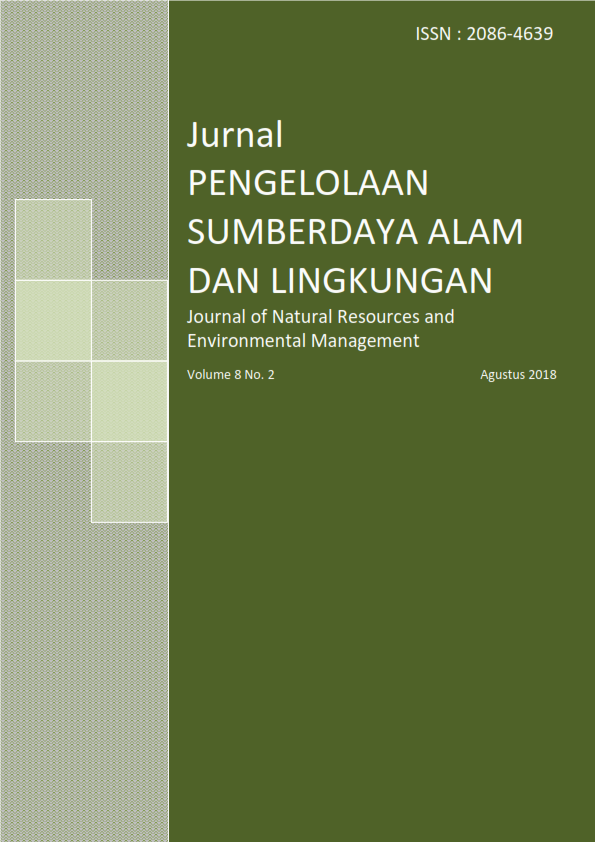IDENTIFIKASI AKTIFIVITAS EKONOMI DAN NILAI EKONOMI SPASIAL DAS CILIWUNG
Abstract
References
Ali, M., 2016. Kajian Dampak Perubahan Penutupan Lahan terhadap Kejadian Banjir pada Lanskap DAS Ciliwung Hilir dengan Pendekatan Sistem Dinamik. Tesis. Sekolah Pascasarjana. Institut Pertanian Bogor, Bogor.
Barbier, E.B., 2004. Explaining Agricultural Land Expansion and Deforestation in Developing Countries. American Journal Economics No. 5, pp.1347-1353.
BPDAS Citarum Ciliwung, 2013. Laporan Rencana Pengelolaan DAS (RPDAS) Terpadu DAS Ciliwung. Kementerian Kehutanan Direktorat Jenderal Bina Pengelolaan DAS dan Perhutanan Sosial Balai Pengelolaan Daerah Aliran Sungai Citarum-Ciliwung, Bogor.
BPS, 2016. DKI Dalam Angka
BPS, 2016. Kabupaten Bogor Dalam Angka
BPS, 2016. Kota Bogor Dalam Angka
BPS, 2016. Kota Depok Dalam Angka
FAO, 2000. Application of Contingent Valuation Method in Developing Countries. FAO Economic and Social Development Papers No. 146/200. FAO, Rome
Fauzi, A., 2014. Valuasi Ekonomi dan Penilaian Kerusakan Sumberdaya Alam dan Lingkungan: Berbagai Informasi Terkait Valuasi Ekonomi Disajikan dengan Dasar Teori yang Kuat dan Metode serta Contoh-Contoh Aplikasinya. IPB Press. Bogor.
Gay, L.R., P.L. Diehl, 1992. Research Methods for Business and Management. MacMillan Publishing Company, New York.
Grigalunas, T.A., R. Congar, 1995. Environmental Economics for Integrated Coastal Area Management: Valuation Methods and Policy Instruments. UNEP Regional Seas Reports and Studies No. 164. ENEP.
Jaya, S.H.I., 2010. Analisis Citra Digital, Teori dan Praktik Menggunakan Erdas Imagine. Fakultas Kehutanan, Institut Pertanian Bogor, Bogor.
Lynden, G.W.J., S. Mantel, 2001. The role of GIS and Remote Sensing in Land Degradation Assessment and Consevation Mapping: Some User Experiences and Expectations. JAG 3, pp. 61-68.
Malhotra, N.K., 1993. Marketing Research and Applied Orientation. Prentice Hall International, USA.
McConnell, W.J., S.P. Sweeney, B. Mulley, 2004, Physical and Social Access to Land: Spatio-temporal Patterns of Agricultural Expansion in Madagascar. Journal Agriculture, Ecosystems and Environment No.101, pp.171-184.
Nazir, M., 2005. Metode Penelitian. Ghalia Indonesia. Jakarta.
Pattanayak, S.K., D.T. Butry, 2005. Spatial Complementarity of Forests and Farms: Accounting for Ecosystem Services. American Journal of Agricultural Economics. 87(4), pp. 995-1008.
Prahasta, E., 2002. Konsep-konsep Dasar Sistem Informasi Geografis. CV Informatika, Bandung.
Ruspendi, D., 2014. Kajian Perubahan Penutupan Lahan pada DAS Ciliwung Hulu dengan Pendekatan Spasial Dinamik. Tesis. Sekolah Pascasarjana, Institut Pertanian Bogor, Bogor.
Solow, R.M., 1956. A Contribution to the Theory of Economic Growth. The Quarterly Journal of Economics. 70(1), pp. 65-94.
Suwarno, J., 2011. Pengembangan Pengelolaan Berkelanjutan Das Ciliwung Hulu Kabupaten Bogor. Disertasi. Sekolah Pascasarjana, Institut Pertanian Bogor, Bogor.
Authors
Authors who publish with this journal agree to the following terms:
- Authors retain copyright and grant the journal right of first publication with the work simultaneously licensed under a Creative Commons Attribution License that allows others to share the work with an acknowledgement of the work's authorship and initial publication in this journal.
- Authors are able to enter into separate, additional contractual arrangements for the non-exclusive distribution of the journal's published version of the work (e.g., post it to an institutional repository or publish it in a book), with an acknowledgement of its initial publication in this journal.
- Authors are permitted and encouraged to post their work online (e.g., in institutional repositories or on their website) prior to and during the submission process, as it can lead to productive exchanges, as well as earlier and greater citation of published work (See The Effect of Open Access).






